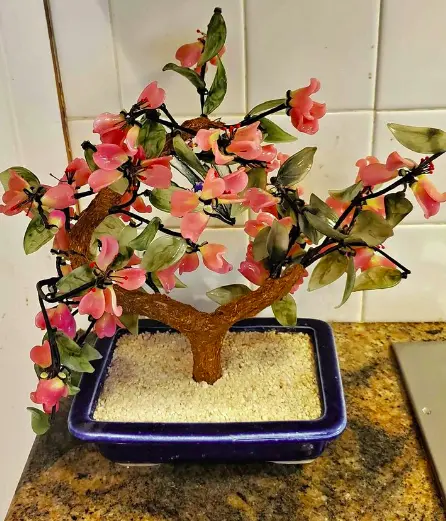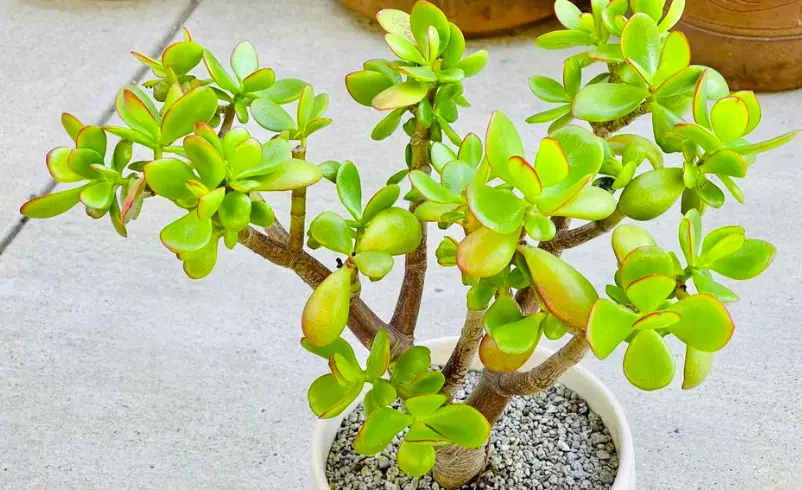Variegated Jade Plants are thought to bring good luck, harmony, and riches. It’s difficult not to want jade plants because they have so many wonderful advantages, which makes them common houseplants. It is easy to grow, and many people love it.
In addition to being simple to cultivate, they are also incredibly easy to reproduce, resulting in tiny Jade plants that you can scatter throughout the house. The edges of the leaves of the Variegated Jade plant occasionally have a red hue and oval-shaped leaves, which makes it quite easy to identify them.
What is Variegated Jade Plant?

The variegated jade foliage is a slow-growing, gracefully branched succulent shrub with interesting green leaves striped in ivory and faint yellow. It can reach heights of up to 4 feet. The up to 2-inch long, succulent leaves frequently have a pink edge on new growth, particularly when grown in direct sunlight. Brown or grey-green segments of the branches are also possible.
Jade trees grow in hot, tropical areas and have smooth, lustrous, green, or yellow leaves on woody, stout stalks. These succulents can resemble trees and reach heights of up to 8 feet (2.5 meters) in the wild.
What Are Varieties Of Variegated Jade Plant
There are over 200 varieties of jade plants that are indigenous to South Africa. They possess jade-green, oval-shaped leaves, which gives them their name.
Here are some varieties of variegated jade plant
1. Money Tree (Crassula Ovata)

The crassula ovata variation of jade plants, also known as the money plant, lucky plant, or dollar plant, is one of the most well-known varieties of variegated jade plants.
The succulent Crassula ovata has light-colored flowers and can be grown indoors and outdoors.
This species, Crassula ovata, sometimes known as the money plant, is the most common jade plant. Because it resembles a tree, some people call this jade plant the money tree.
2. Pink Jade Plant
This jade plant, sometimes known as the “Pink Beauty,” exhibits more pink hues than green hues. You can find pink blooms on the Pink Jade Plant; this variety’s stems are pink rather than the typical brown color of jade plants.
On the vibrant stems, the obovate leaves are quite a few. With a mature plant reaching a height of up to 5 feet (1.5 meters), this pink jade variety is also one of the wider varieties.
3. Blush Plakkie
The Blush Plakkie is a member of the jade species and is also known as the “Sharp-leaved Crassula.” The reddish stem and light green, elongated tear-shaped leaves of this jade cultivar help you identify it.
The height of this miniature jade tree, which only reaches approximately 32″ (80 cm), is more akin to a shrub than a traditional tree. When it blooms, it produces little, loose clusters of yellowish flowers at the ends of the stalks.
4. Chinese Jade

This variegated jade plant called Chinese jade does very well as an indoor plant, and no matter tge direction you place this plant, it will bring harmony and good luck to your home. Its green leaves tend to turn black if affected by too much sunlight.
5. Silver Jade Plant

This plant looks like a dollar. Its name is derived from its grayish-silver leaves; apart from its connection to wealth, this plant does well indoors and outdoors.
6. Crosby’s Compact Dwarf Jade Plant
The jade cultivar is “Crosby’s Compact” and resembles a small succulent shrub rather than a jade tree. The plant has a warm, comfortable appearance.
The leaves of this dwarf jade grow to an inch (2.5 cm), shorter than those of other jade plants.
7. Golden Jade Tree (Hummel’s Sunset)

This kind of Crassula jade has thick branches and woody stems. These grow fleshy, tear-shaped leaves with crimson margins that are vivid colors of lime green and yellow with red borders.
The jade cultivar “Hummel’s Sunset” is a prize-winning beauty with green and golden yellow leaves. The foliage’s stunning colors are one of the reasons it is also known as the “Golden jade tree.”
The height of this jade tree only reaches approximately 32″ (80 cm); when it blooms, it produces little, loose clusters of yellowish flowers at the ends of the stalks.
How To Propagate Variegated Jade Plant?
There are a few options for handling propagation. There is propagation using leave cutting and also propagation by stem cutting.
Stem and leaf cuttings are the two methods of propagation used most frequently. Both are relatively simple, just as simple as stem-cutting propagation is leaf-cutting propagation. The process has minor variations, but the outcome is the same.
How To Grow Variegated Jade Plant From Leaf Cuttings?
Spring is the best time to propagate leaf or stem cuttings; the procedure is similar for growing plants from a single leaf cutting.
Cut Leave From A Robust Green Jade Plant
The plumper, the better; the nicest thing about leaf propagation is that you can pluck or cut multiple leaves at once from a robust jade plant without harming the plant or giving it an imbalanced appearance.
When you cut leaves for propagation, make sure to take off only the healthy leaf with your fingers, carefully including the node at the base.
The chosen leaves must be gently removed, taking a piece of the node along them. Peel the leaf back gently so that it separates from the stem in a neat fashion. If done properly, the end should have a small bend where the leaf once connected to the stem.
All the leaves should be placed on a piece of newspaper to dry out gradually.
After that,
Press The Leaf into the Soil
After successfully cutting leaves, press leaves into the soil. To propagate jade plants, the optimum soil for leaf propagation is moist, well-draining soil.
The base should be lightly pressed into the ground, and tilt the leaf upward. Make sure it is firm on the soil and doesn’t fall.
How To Grow Variegated Jade Plant From Stem Cuttings
This stem-cutting technique is typically the best and will produce the quickest results; if you desire a houseplant that will grow quickly and bloom, use the stem method.
There are four easy stages you can follow for stem propagation. They include;
Pick A Healthy Stem
Choosing a healthy stem is the first step in the propagation process. Ensure the cutting is in good condition without cuts or scraping; this gives it the best opportunity of developing roots.
Also, It should have numerous green leaves as of the top and be around 4 inches in length.
Store For A Week
After successfully cutting healthy stems of your desired jade plant, please place them in a newspaper for a few days. This step is optional; it does give you a better chance for success because it stops any possible stem rotting. The cutting should be ready to grow in about a week.
Plant In Damp Soil
To plant the cutting, bury the bottom half entirely by planting your finger into the ground. Make sure the soil is moist; after planting your health stem cutting, there is no need to water it immediately.
Remember to remove any significant air bubbles and press around the base of the cutting to secure it in place.
Caring for Variegated Jade Plant
Everyone loves plants with little maintenance, and the variegated jade plant best suits your busy schedule and blooms well without much care.
Variegated Jade plants require very little maintenance and may even flourish in dim lighting. The only significant maintenance required for a jade plant is occasional watering, moderate pruning, and putting them out of direct sunlight, which will change the color of their leaves.
Here are some requirements for your variegated jade plant;
1. Soil
It thrives in neutrally speed, well-drained soil. Add pine bark and coconut coir to improve the soil’s ability to drain. To make your potting soil for your jade plant, you can.
Add sand or fine grave to make potting soil loose and chunky.
2. Light
It grows well in bright light with some direct sunlight. A sunny windowsill will be an ideal position for these plants.
The variegated jade plant will not bloom without sunlight, and inadequate light will cause developing spindly growth. Too much light also affects variegated jade plants by tiring the leaves dark.
3. Water
Before re-watering, let the soil’s surface dry out slightly. Water Plant only when needed. What should sparingly but consistently water the variegated jade plant during the growing season?
4. Humidity
Despite your intention to delight them with water misting, they naturally thrive in rather humid environments.
5. Temperature
Your jade plant needs a certain temperature to be healthy and bloom; they require consistently warm temperatures to flourish their best because of their warm native environments.
Although mild temperatures are more probable when growing indoors, they can withstand higher temperatures.
6. Fertilizer
During the spring through summer growing season, fertilize after two weeks using a mixed liquid fertilizer diluted by half.
Winter time is not the time to fertilize your variegated jade plant; You can feed your succulent plants with such a ½ succulent fertilizer if their development has stopped.
Jade plants grow slowly and don’t need a lot of feeding. You don’t need to care about fertilizer when cultivating these plants.
7. Re-potting
When the plant becomes root-bound or the soil needs to be refreshed, repot it in the spring. Jade plants are notorious for being top-heavy, so it is best to use a very solid and heavy pot, and they won’t fall over if you put a heavy pot on them.
8. Pruning
Early in the spring is a good time to prune jade plants because that is when new growth starts. Determine how you want to arrange the plant by looking at the overgrown stems.
Cut off excessive stems and remove problematic branches with sharp scissors.
Pests And Control
Pest can harm variegated jade plants. Use an appropriate pesticide or insecticide that is designated for jade plants before using it as a spray.
Popular indoor plants, jade plants are fairly low maintenance and do well in most interior settings. Jade could do better in cold or wet weather. It turns yellow and mushy, losing its color, and it turns black in cases of too much light.
Ensure to provide the best conditions for your variegated jade plants if you want to see them bloom.
